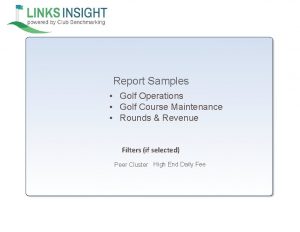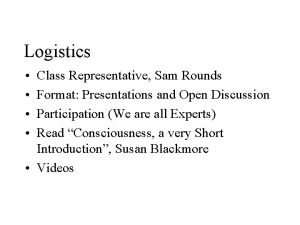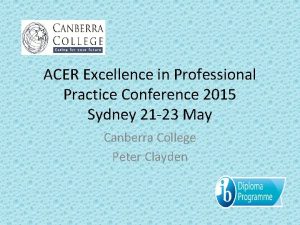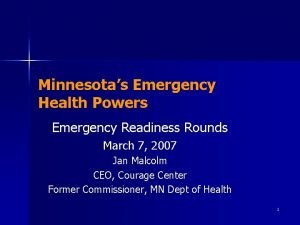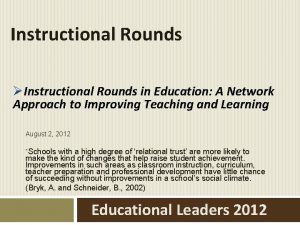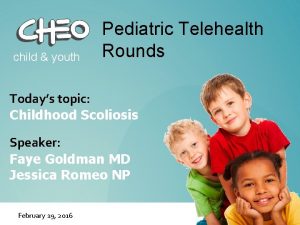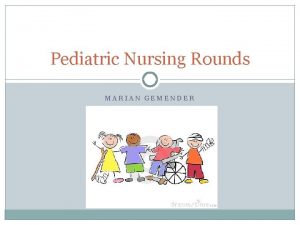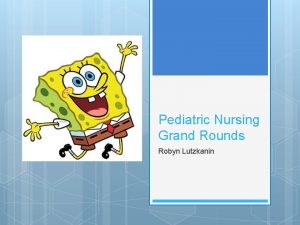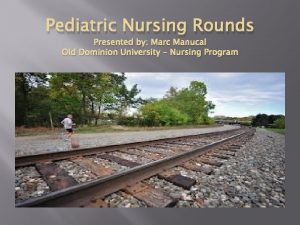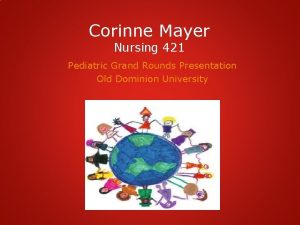Creating a good research question Pediatric Research Rounds





















- Slides: 21

Creating a good research question… Pediatric Research Rounds Dr. LA Allwood Newhook

outline • Research sequence • Research ideas • What is a research question – Qualities of a good question – Primary versus secondary • • FINER PICO Examples Checklist

Research Sequence 1. Development of a research idea 2. Formulating a research question – – – Review of the literature Primary research question Secondary research questions 3. Develop the protocol – – Sample size Pretest/revise the protocol 4. Funding 5. Ethics/ institutional approvals 6. Do the Study – – – recruitment analysis conclusions 7. Knowledge Translation – – Present research publish

Where do research ideas come from? • Clinical practice • Observations of patients • Talking with colleagues, other researchers • National meetings and conferences • Reading the literature • New advances bring new questions…. • Teaching and students • Skeptical about prevailing beliefs

What is a research question? “ A research question is a clear unambiguous question able to be answered through your research project” (Albert et al) “A research question is an excellent way to pull things together. Writing a research question forces you to focus your thoughts and summarize your goals in a single interrogative sentence…” (Belgrave et al)

What are the qualities of a good research question? • Narrowed to a concrete, focused, researchable issue • Transformable into a feasible and valid study plan • After a detailed literature review, there should be evidence that there is a need for your study; it addresses a scientific or medical knowledge gap • Is it important to patients?


What are Primary and Secondary Questions? • A single primary question around which to focus the development of the protocol and sample size estimates • Secondary research questions: can be related to the primary question or to other hypotheses • Common error : overloading the study with too many objectives and too much data collection (keep it simple)

Is your research question FINER? • • • Feasible Interesting Novel Ethical Relevant

Feasible • Is the scope of the project manageable? • Do you have access to participants? – What is preliminary sample size? • Do you and your research team have the necessary expertise? • Do you have adequate resources (time, money, personnel, equipment)?

Novel • Confirm or refute previous findings • Extend knowledge of previous findings • Provide new findings

Interesting • Is your question interesting to your peers? Your research team? • Will it be interesting to the funding source? • Will you be able to publish your results? • Getting to the truth is interesting!

Ethical • Your study should not pose unacceptable physical risks or invasion of privacy • Discuss with HREA

Relevant • What are the various possible outcomes? • How can each outcome: – Advance scientific knowledge – Influence clinical management and health policy – Guide future research • Is it important to patients?

PICO • An acronym used in formulating patientcentered questions. – What is the Patient, Population, or Problem? – Which Intervention is being considered? – What Comparator to this intervention will be used? – What Outcome will be measured?

The P. I. C. O. Model for Clinical Questions P Patient, Population, or Problem How would I describe a group of patients similar to mine? I Intervention, Prognostic Factor, or Exposure Which main intervention, prognostic factor, or exposure am I considering? C Comparison or Intervention What is the main (if appropriate) alternative to compare with the intervention? O Outcome you would like to What can I hope to measure or achieve accomplish, measure, improve, or affect? What Type of question are you asking? Diagnosis, Etiology/Harm, Therapy, Prognosis, Prevention Type of Study you want to find What would be the best study design/methodology?

Writing your research question: 1. Write down the question… – What is the uncertainty that you want to resolve – Begin with a general concern then narrow down to a concrete, researchable idea 2. Master the literature in that area – Read, read… – Focus on studies that support the need for your study 3. Establish a single primary research question which you will use to develop study plan and estimate sample size – supplement with secondary questions

Examples • What is the relationship between depression and health? – Interesting, but vague – Should operationally define “depression” and “health” – Difficult to determine causality – does depression lead to worse health or vice versa? – what population? “Among postpartum mothers, does post-partum depression assessed by the “PPD questionnaire” predict health status of their children by age 5 years as measured by the “Child Health Inventory Scale” at age 5 years? ” – Is this FINER compatible? – Is this PICO compatible?

Examples • Does parental smoking cause cancer in children? – Interesting, but vague “Is the amount of environmental tobacco smoke exposure in infancy as measured by infant urinary and hair cotinine levels, associated with the occurrence of childhood cancer by age 14? ” – Is this FINER compatible? – Is this PICO compatible?

Research Question Check-list: FINER PICO q Is it a clear unambiguous question? q Is it summarized in a single sentence? q Is it feasible? q Is it interesting? q Is it novel? q Is it ethical? q Is it relevant? q Is the Patient, Population, or Problem described? q Is the Intervention, Prognostic Factor, or Exposure described? q Have you considered the comparison or intervention (if appropriate)? q Have you chosen the primary and secondary outcomes you would like to measure or achieve?

 Costas higher level questions
Costas higher level questions Vague questions examples
Vague questions examples Factor isolating question about social media
Factor isolating question about social media Good thoughts good words good deeds zoroastrianism
Good thoughts good words good deeds zoroastrianism Good evening good afternoon
Good evening good afternoon Good afternoon teacher
Good afternoon teacher You are good when there's nothing good in me
You are good when there's nothing good in me Good afternoon buenas tardes
Good afternoon buenas tardes Persuasive speech examples
Persuasive speech examples Utmb grand rounds
Utmb grand rounds .75 rounded to the nearest tenth
.75 rounded to the nearest tenth Maths quiz rounds names
Maths quiz rounds names Superfluous dimensions
Superfluous dimensions 5 layers of neurosis gestalt
5 layers of neurosis gestalt A is an odd number which rounds to 100 000
A is an odd number which rounds to 100 000 Maintenance rounds
Maintenance rounds Schwartz rounds facilitator training
Schwartz rounds facilitator training Sam rounds
Sam rounds Quality teaching rounds coding sheet
Quality teaching rounds coding sheet Red white and blue tortilla chips
Red white and blue tortilla chips Readiness rounds
Readiness rounds Cartridge cases
Cartridge cases















